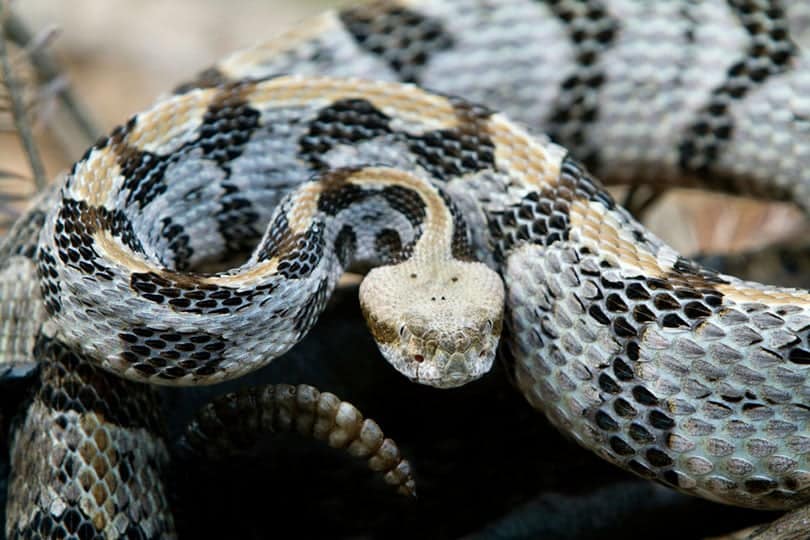Indiana is the home of the Indianapolis 500, one of the most famous car races in the world. It’s also where you’ll find 32 species of snakes, none of them as fast or as famous as the Indy 500 competitors. These snakes won’t win any races, but they are champions at keeping pesky rodents under control. Keep your eye out, a few on our list are venomous snakes. We’ll tell you how to identify them from their harmless cousins.

The 32 Snakes Found in Indiana
1. Eastern Copperhead (Venomous)
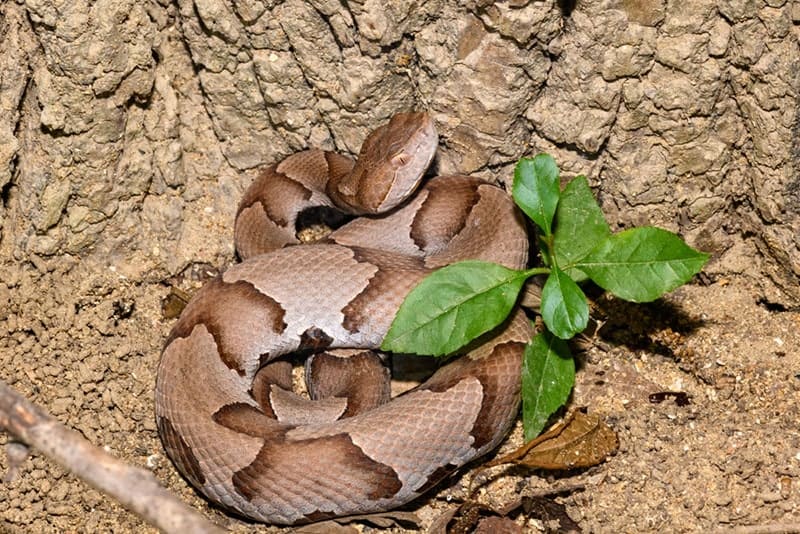
| Species: | A. contortrix |
| Longevity: | 18 years |
| Good to own as a pet?: | No |
| Legal to own?: | In Indiana with permit |
| Adult size: | 22-36 inches (56-91 cm) |
| Diet: | Carnivorous |
The most common venomous snake in Indiana, copperheads are found in forest habitats in the southern part of the state. Look for a triangle-shaped head and slit-like pupils to distinguish this snake from similar non-venomous species.
2. Cottonmouth (Venomous)

| Species: | A. piscivorus |
| Longevity: | 10 years |
| Good to own as a pet?: | No |
| Legal to own?: | Not in Indiana, endangered |
| Adult size: | 24-48 inches (61-122 cm) |
| Diet: | Carnivorous |
A venomous water snake, the cottonmouth is rarely seen in Indiana. They inhabit wetland locations and can swim with their entire bodies out of the water. When threatened, they often open their white-lined mouths wide, behavior that earned them their name.
3. Eastern Massasauga (Venomous)
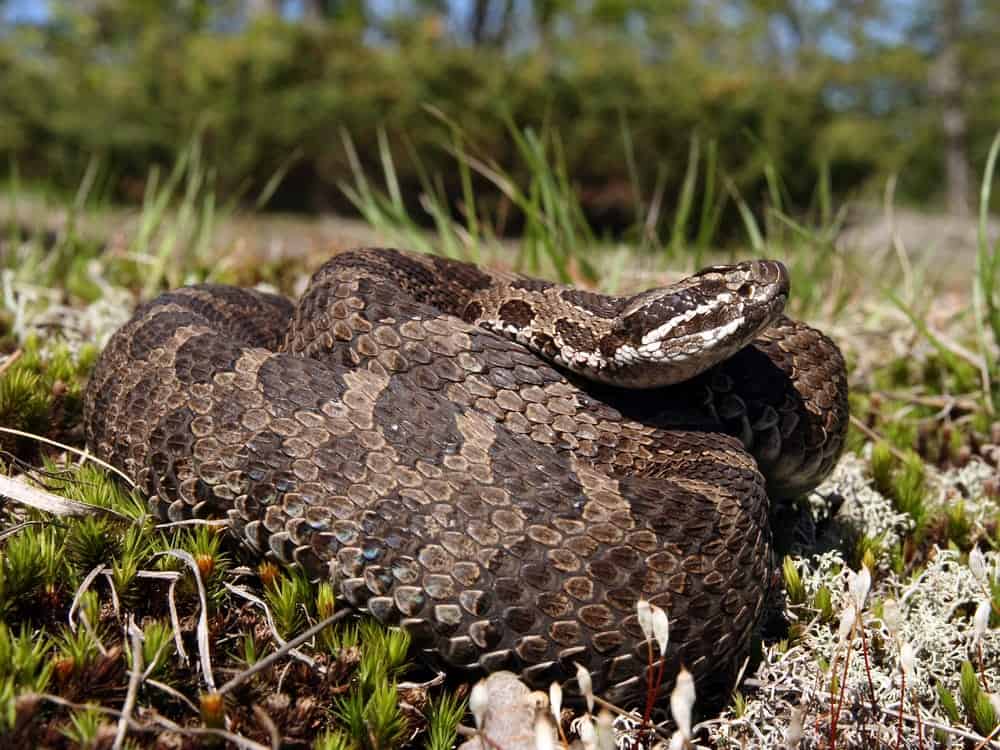
| Species: | S. catenatus |
| Longevity: | 14 years |
| Good to own as a pet?: | No |
| Legal to own?: | Not in Indiana, endangered |
| Adult size: | 24 inches (61 cm) |
| Diet: | Carnivorous |
Small, venomous rattlesnakes, the eastern massasauga is endangered due to the loss of its wetland habitat. Found in northern Indiana, their rattle and the thick dark stripe over their eyes help distinguish the massasauga from similar-looking species.
4. Timber Rattlesnake (Venomous)

| Species: | C. horridus |
| Longevity: | 10-20 years |
| Good to own as a pet?: | No |
| Legal to own?: | Captive-bred, with permit only |
| Adult size: | 30-60 inches (76-152 cm) |
| Diet: | Carnivorous |
Heavy-bodied venomous snakes, timber rattlers are found in the forests of central Indiana. Loss of habitat and deliberate killing has led to a large population decline and they are now endangered in the state.
5. Copper-Bellied Watersnake
| Species: | N.e. neglecta |
| Longevity: | Unknown |
| Good to own as a pet?: | Yes |
| Legal to own?: | Not in Indiana, endangered |
| Adult size: | 24-48 inches (61-122 cm) |
| Diet: | Carnivorous |
Black with orange-red bellies, these large water snakes are threatened by loss of habitat and illegal collection for the pet trade. They eat mainly frogs and tadpoles and are hunted by raptors, snapping turtles, and raccoons.
6. Diamond-Backed Watersnake
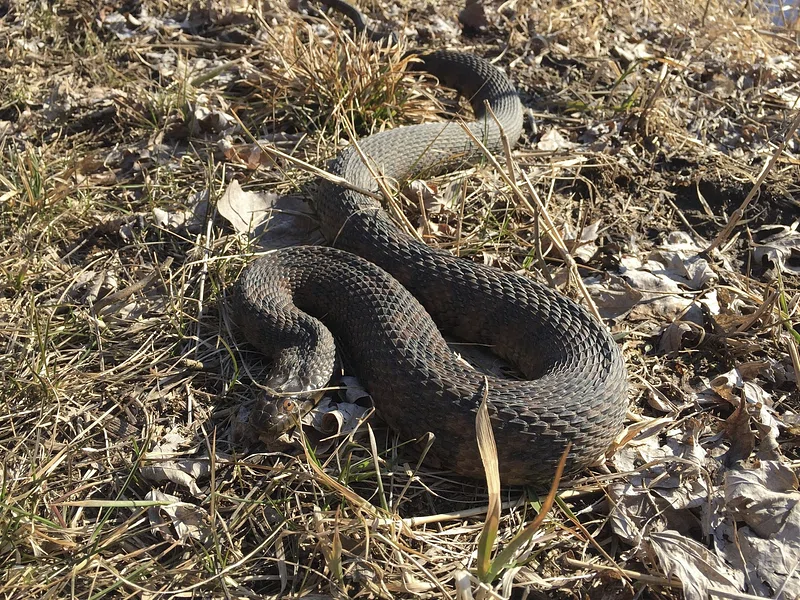
| Species: | N. rhombifer |
| Longevity: | 9 years |
| Good to own as a pet?: | No |
| Legal to own?: | With permit only, endangered |
| Adult size: | 36-48 inches (91-122 cm) |
| Diet: | Carnivorous |
A large water snake, the diamond-back is gray or olive with a dark diamond-shaped pattern. Found in lakes, rivers, and streams, they prey on slow-moving fish and amphibians and will bite if threatened, though they are non-venomous.
7. Northern Watersnake

| Species: | N. sipedon |
| Longevity: | 9 years |
| Good to own as a pet?: | Yes |
| Legal to own?: | Yes with permit |
| Adult size: | 24-55 in (61-140 cm) |
| Diet: | Carnivorous |
Often mistaken for cottonmouths, northern watersnakes are found in slow-moving water habitats throughout Indiana. They swim with only their head out of the water, unlike cottonmouths, and can be cranky enough to bite if threatened.
8. Butler’s Garter Snake
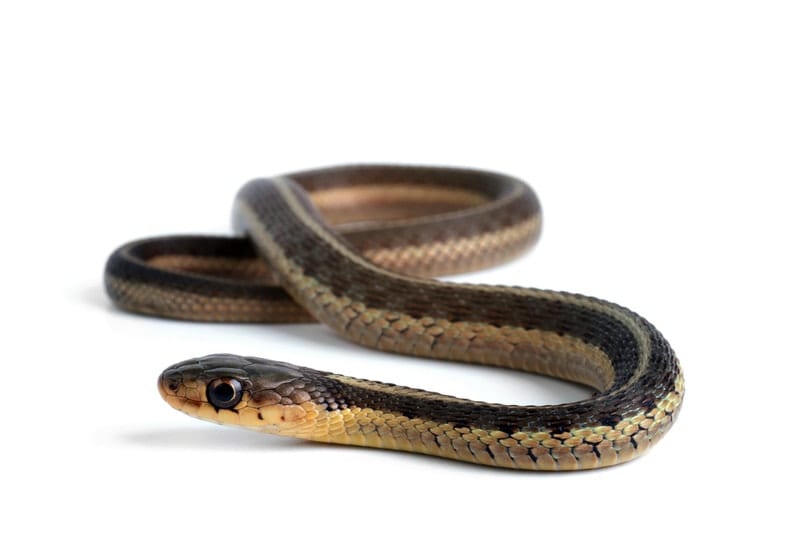
| Species: | T. butleri |
| Longevity: | 6-10 years |
| Good to own as a pet?: | No |
| Legal to own?: | Not in Indiana, endangered |
| Adult size: | 15-20 inches (38-50 cm) |
| Diet: | Carnivorous |
Small, striped snakes, often confused with the more common eastern garter snake, this species is endangered in Indiana due to habitat loss. They eat earthworms and live in moist environments.
9. Eastern Garter Snake
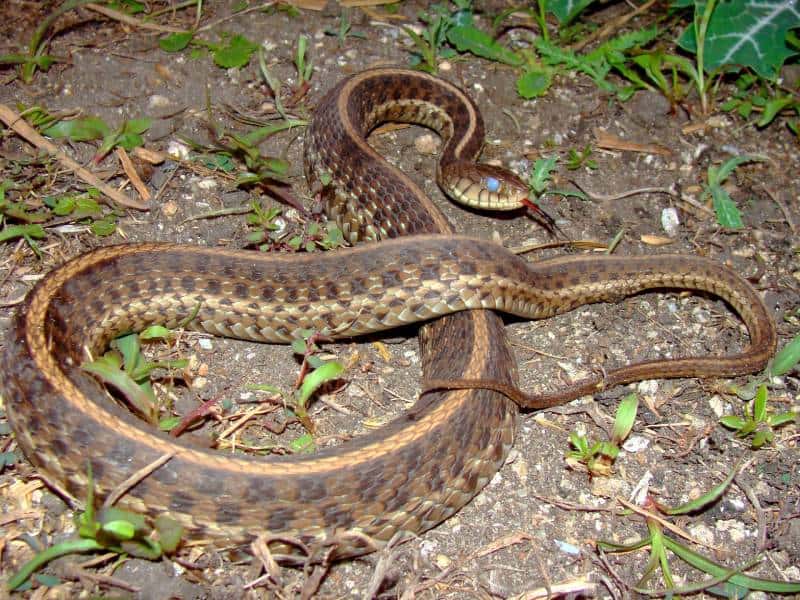
| Species: | T. sirtalis |
| Longevity: | 3-4 years |
| Good to own as a pet?: | Yes |
| Legal to own?: | Yes with permit |
| Adult size: | 18-26 inches (46-66 cm) |
| Diet: | Carnivorous |
These snakes are common throughout Indiana. Eastern garter snakes live in a variety of habitats, from cities to forests, and eat both vertebrate and invertebrate prey.
10. Eastern Ribbonsnake

| Species: | T. sauritus |
| Longevity: | 12-20 years |
| Good to own as a pet?: | Yes |
| Legal to own?: | Yes |
| Adult size: | 16-28 inches (41-71 cm) |
| Diet: | Carnivorous |
Dark with three light stripes, these shy but speedy snakes live near water sources and eat frogs and salamanders.
11. Plains Garter Snake
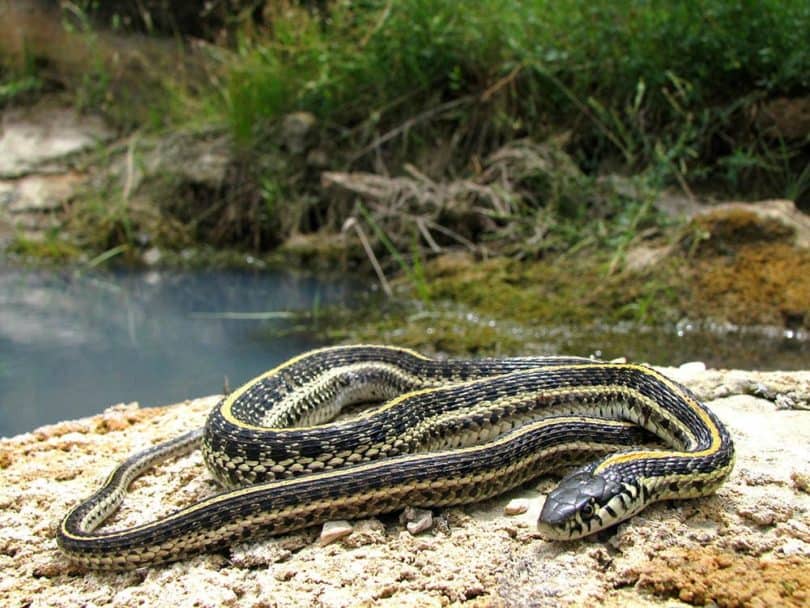
| Species: | T. radix |
| Longevity: | 10 years |
| Good to own as a pet?: | Yes |
| Legal to own?: | Yes with permit |
| Adult size: | 16-28 inches (41-71 cm) |
| Diet: | Carnivorous |
Similar in appearance to eastern garter snakes, this species has a brighter orange stripe down its back. Plains garter snakes are only found in the northwest corner of Indiana.
12. Western Ribbon Snake

| Species: | T. proximus |
| Longevity: | 3-6 years |
| Good to own as a pet?: | Yes |
| Legal to own?: | Captive-bred only |
| Adult size: | 20-30 inches (41-76 cm) |
| Diet: | Carnivorous |
Western ribbon snakes have a bright orange back stripe and white dot on their head, distinguishing them from their eastern cousins. Their habitat is sandy areas near water sources.
13. Queensnake

| Species: | R. septemvittata |
| Longevity: | Unknown |
| Good to own as a pet?: | Yes |
| Legal to own?: | Yes with permit |
| Adult size: | 15-24 inches (38-61 cm) |
| Diet: | Carnivorous |
Queen snakes are small, brown water snakes, found near shallow streams. They eat crayfish and release a foul-smelling liquid if attacked.
14. Kirtland’s Snake
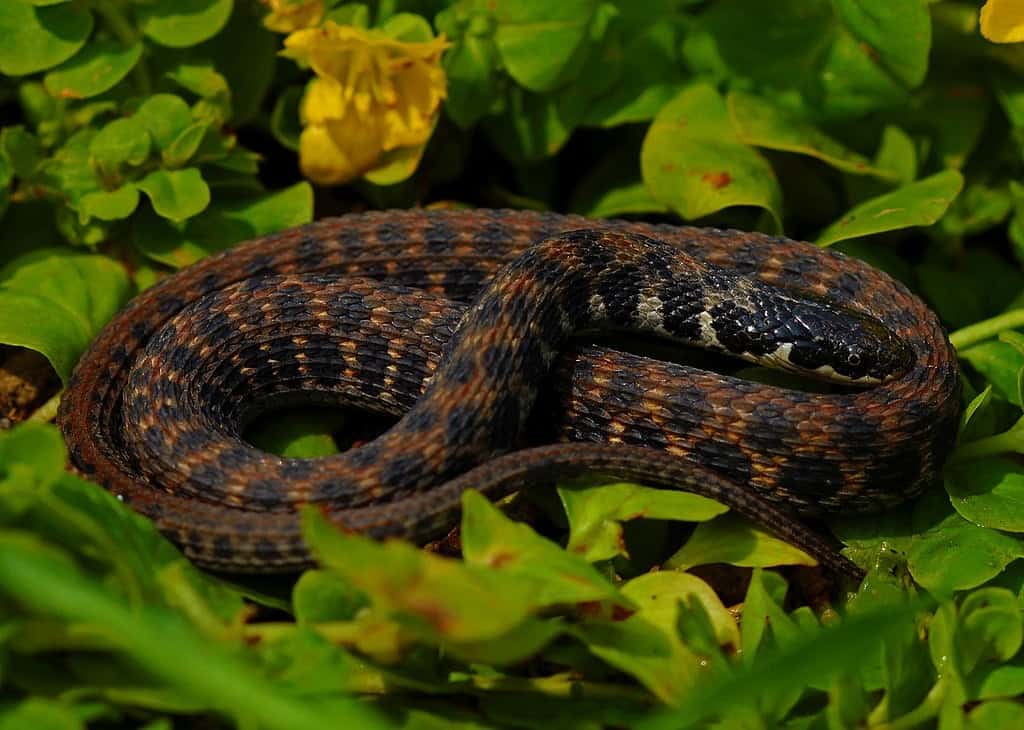
| Species: | C. kirtlandii |
| Longevity: | 5 years |
| Good to own as a pet?: | Yes |
| Legal to own?: | Not in Indiana, endangered |
| Adult size: | 14-24 inches (36-61 cm) |
| Diet: | Carnivorous |
These snakes are identified by their bright red bellies lined with black dots. Kirtland’s snakes live in wet prairie and meadow habitats.
15. Dekay’s Brown Snake
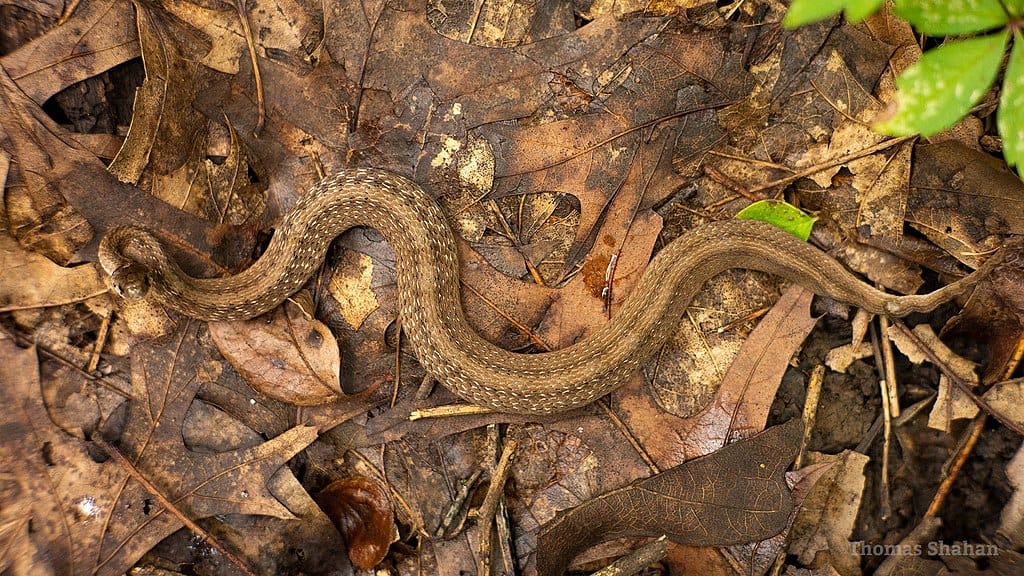
| Species: | S. dekayi |
| Longevity: | 7 years |
| Good to own as a pet?: | Yes |
| Legal to own?: | Yes with permit |
| Adult size: | 9-21 inches (23-53 cm) |
| Diet: | Carnivorous |
Shy Dekay’s brown snakes are rarely spotted in the wild. They are adapted to a wide variety of habitats from backyards to prairies.
16. Red-Bellied Snake
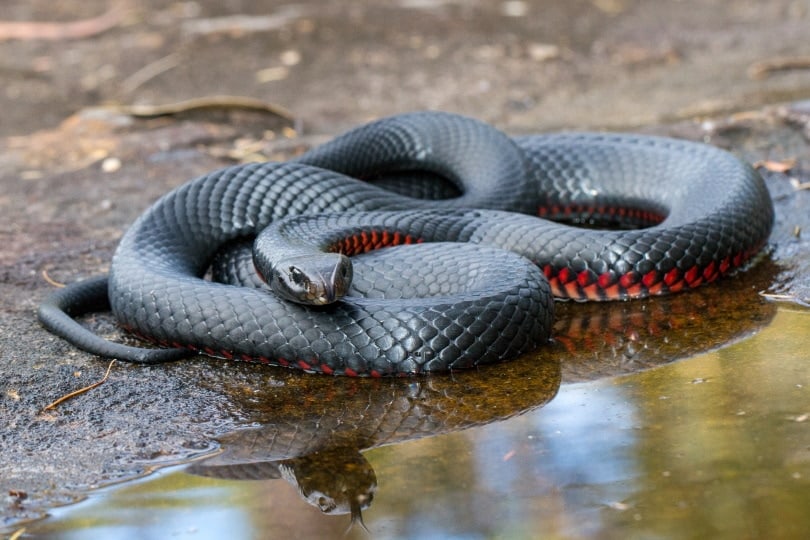
| Species: | S. occipitomaculata |
| Longevity: | 4 years |
| Good to own as a pet?: | No |
| Legal to own?: | Yes |
| Adult size: | 8-16 inches (20-41 cm) |
| Diet: | Carnivorous |
Red-bellied snakes are distinguished from Kirtland’s snakes by the lack of dots lining their red bellies. They live in wooded areas and eat mostly slugs and worms.
17. Smooth Earth Snake

| Species: | V. valeriae |
| Longevity: | 9 years |
| Good to own as a pet?: | No |
| Legal to own?: | Yes with permit |
| Adult size: | 7-10 inches (18-25 cm) |
| Diet: | Carnivorous |
These tiny brown snakes are found in wooded areas, hiding under logs and dead leaves. Smooth earth snakes eat worms and insect larvae.
18. Blue Racer
https://www.instagram.com/p/CdVojbSs8YK/
| Species: | C. constrictor |
| Longevity: | 10 years |
| Good to own as a pet?: | No |
| Legal to own?: | Yes with permit |
| Adult size: | 20-60 inches (50-152 cm) |
| Diet: | Carnivorous |
Blue racers prefer open habitats and are known to charge humans if confronted, but will back off quickly if their bluff is called.
19. Rough Green Snake
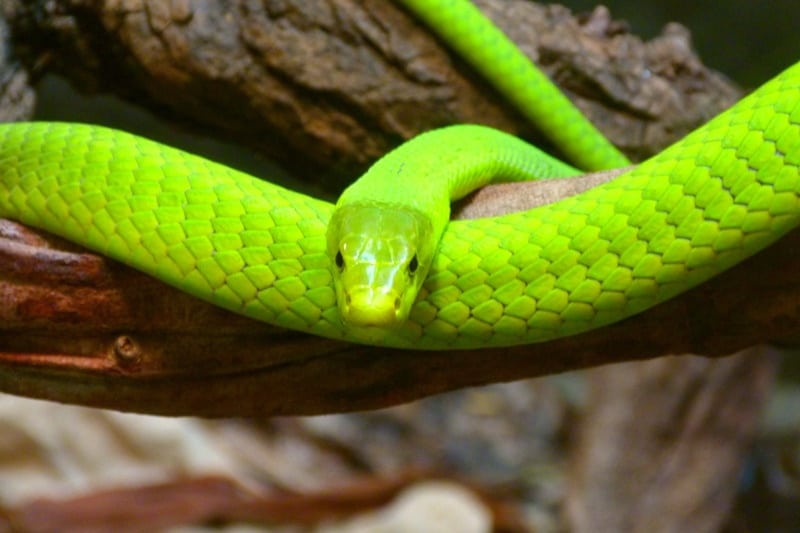
| Species: | O. aestivus |
| Longevity: | 8 years |
| Good to own as a pet?: | Yes |
| Legal to own?: | Yes with permit |
| Adult size: | 22-32 inches (56-81 cm) |
| Diet: | Carnivorous |
Slender bright green snakes, this species is found in wooded habitats in southern Indiana. Talented tree climbers, rough green snakes eat primarily insects.
20. Smooth Green Snake
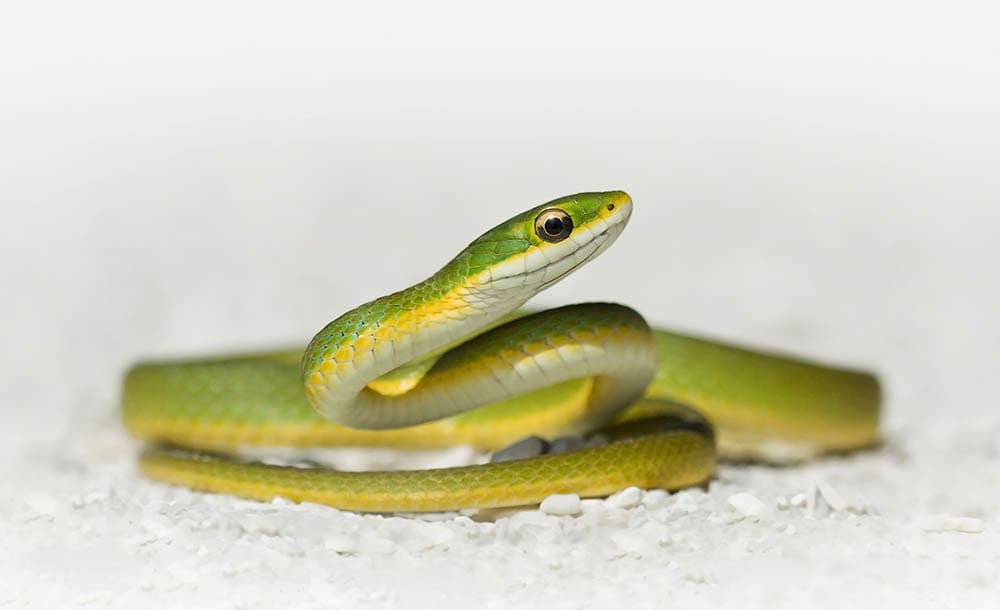
| Species: | O. vernalis |
| Longevity: | 10 years |
| Good to own as a pet?: | No |
| Legal to own?: | Captive-bred only, endangered |
| Adult size: | 11-20 in (28-51 cm) |
| Diet: | Carnivorous |
These snakes look similar to the rough green snake but are found only in northwestern Indiana. They are endangered in the state due to the loss of their wet prairie habitat.
21. Gray Rat Snake

| Species: | P. spiloides |
| Longevity: | 10-15 years |
| Good to own as a pet?: | Yes |
| Legal to own?: | Yes with permit |
| Adult size: | 42-72 inches (107-183 cm) |
| Diet: | Carnivorous |
The longest snake in Indiana, gray rat snakes are found in forests throughout the state. They spend much of their time up in trees.
22. Eastern Foxsnake
| Species: | P. vulpinus |
| Longevity: | 8-17 years |
| Good to own as a pet?: | Yes |
| Legal to own?: | Yes with permit |
| Adult size: | 36-54 inches (91-137 cm) |
| Diet: | Carnivorous |
Eastern foxsnakes are found in grassy habitats in northwestern Indiana. They kill their prey—mostly rodents—by constriction.
23. Bullsnake
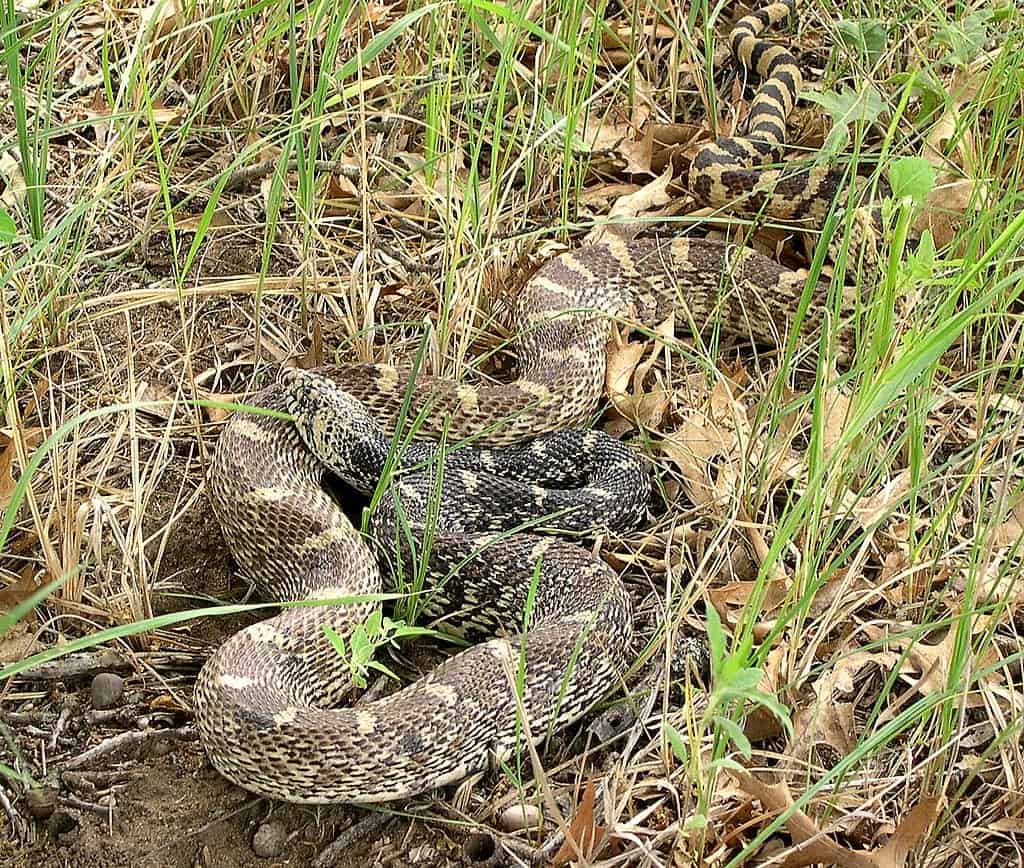
| Species: | P. catenifer |
| Longevity: | 12 years |
| Good to own as a pet?: | Yes |
| Legal to own?: | Yes with permit |
| Adult size: | 37-72 inches (94-183 cm) |
| Diet: | Carnivorous |
Bullsnakes are found in open, grassy habitats where they hunt mice, squirrels, rabbits, and birds. They hiss and rattle their tails to intimidate potential enemies.
24. Eastern Milksnake

| Species: | L. triangulum |
| Longevity: | 12-20 years |
| Good to own as a pet?: | Yes |
| Legal to own?: | Yes with permit |
| Adult size: | 24-36 inches (61-91 cm) |
| Diet: | Carnivorous |
These common snakes are found throughout the state, in habitats ranging from forests to open grasslands. Milksnakes are light gray-brown with darker brown markings.
25. Prairie Kingsnake
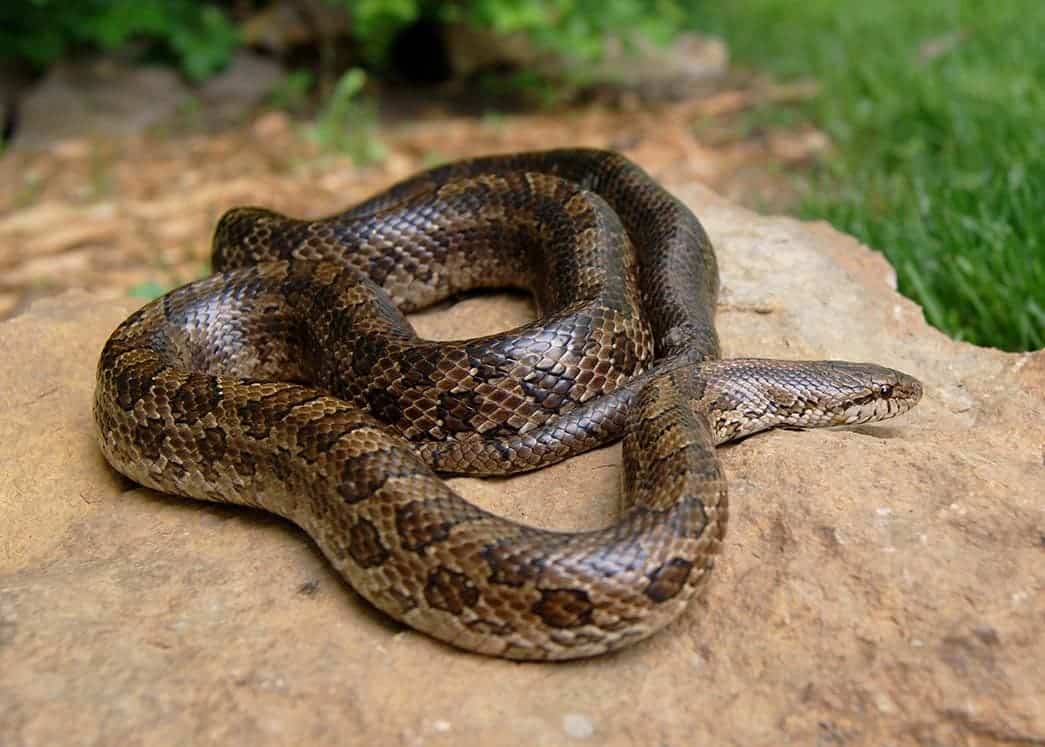
| Species: | L. calligaster |
| Longevity: | 12-16 years |
| Good to own as a pet?: | Yes |
| Legal to own?: | Yes with permit |
| Adult size: | 24-42 inches (61-107 cm) |
| Diet: | Carnivorous |
Prairie kingsnakes are found mostly in southwestern Indiana where they inhabit fields and other grassy habitats. These snakes are useful in controlling local rodent populations.
26. Scarletsnake

| Species: | C. coccinea |
| Longevity: | 10 years |
| Good to own as a pet?: | No |
| Legal to own?: | Not in Indiana, endangered |
| Adult size: | 14-20 inches (36-51 cm) |
| Diet: | Carnivorous |
Scarletsnakes are rare and endangered in Indiana. They look similar to eastern milksnakes but with an unmarked white belly and a more pointed head.
Related Read: 10 Snakes Found in Florida (with Pictures)
27. Southeastern Crowned Snake
| Species: | T. coronata |
| Longevity: | Unknown |
| Good to own as a pet?: | No |
| Legal to own?: | Not in Indiana, endangered |
| Adult size: | 8-10 inches (20-25 cm) |
| Diet: | Carnivorous |
These tiny brown snakes with black heads are rare in Indiana. They are found in rocky habitats where they eat insects and spiders.
28. Ring-Necked Snake
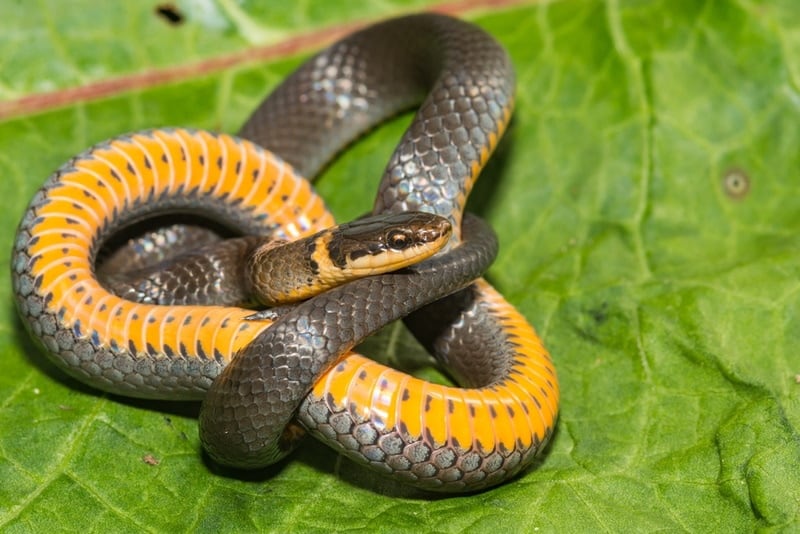
| Species: | D. punctatus |
| Longevity: | 10-20 years |
| Good to own as a pet?: | No |
| Legal to own?: | Yes with permit |
| Adult size: | 10-15 in (61-122 cm) |
| Diet: | Carnivorous |
Found anywhere they can find good hiding spots, these snakes are distinctive in appearance, dark gray with bright yellow belly and a white ring around the neck. Ring-necked snakes eat salamanders, worms, and frogs.
29. Common Wormsnake
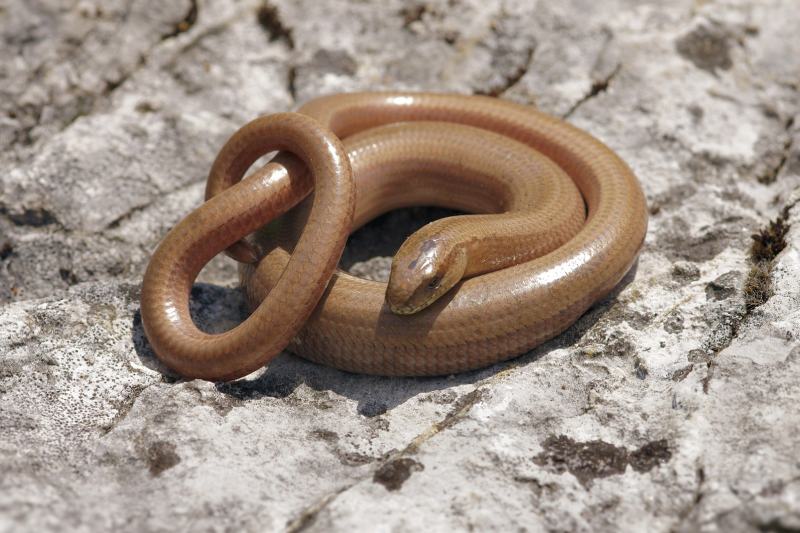
| Species: | C. amoenus |
| Longevity: | 4 years |
| Good to own as a pet?: | Yes |
| Legal to own?: | Yes with permit |
| Adult size: | 5.5-12 inches (14-30 cm) |
| Diet: | Carnivorous |
Not much bigger than a large nightcrawler, these snakes both look and act more like worms than they do other snakes. Wormsnakes burrow into the ground in their forest habitats.
30. Eastern Hog-Nosed Snake

| Species: | H. platirhinos |
| Longevity: | 12 years |
| Good to own as a pet?: | Yes |
| Legal to own?: | Yes with permit |
| Adult size: | 28-46 inches (71-117 cm) |
| Diet: | Carnivorous |
Identified by their unique upturned snout, eastern hognose snakes are found in sandy habitats. When threatened, their defense display is elaborate and bizarre. They hiss and puff up like cobras, strike with an open mouth and as a last resort, flop around and play dead.
31. Red-Bellied Mudsnake

| Species: | F. abacura |
| Longevity: | 19 years |
| Good to own as a pet?: | No |
| Legal to own?: | Not in Indiana, endangered |
| Adult size: | 40-54 inches (102-137 cm) |
| Diet: | Carnivorous |
Rare and possibly extinct from the state, red-bellied mudsnakes are dark with a red and black checkerboard pattern on their bellies. They live in swamps and wetlands and eat only a type of aquatic salamander called a siren.
32. Black Kingsnake

| Species: | L. getula |
| Longevity: | 13 years |
| Good to own as a pet?: | Yes |
| Legal to own?: | Yes with permit |
| Adult size: | 36-45 inches (91-114 cm) |
| Diet: | Carnivorous |
Black with a white and black pattern near their mouth, these kingsnakes often live in overgrown fields. They may prey on venomous snakes, like copperheads, and are immune to their poison.

Conclusion
Often feared and misunderstood, these 32 snakes are an essential part of Indiana’s natural world. Most snakes shy away from any human contact. Those that you do encounter are more afraid of you than you should be of them. Educate yourself on how to identify the four venomous snakes found in Indiana and avoid them if you see them–but you probably won’t!
Related read:
- 15 Snakes Found in Maryland (with Pictures)
- 10 Types of Garter Snakes: Morphs & Colors (with Pictures)
Featured Image Credit by Mark_Kostich, Shutterstock
